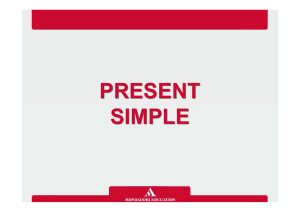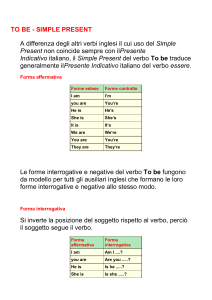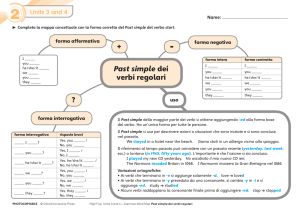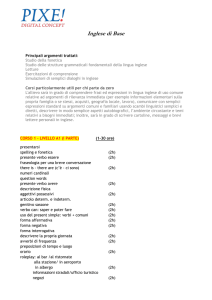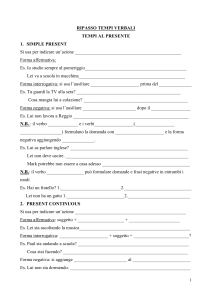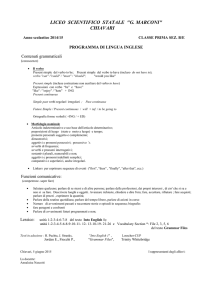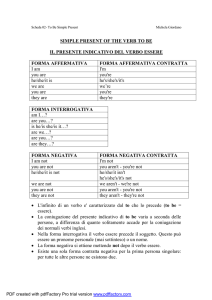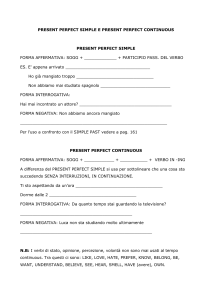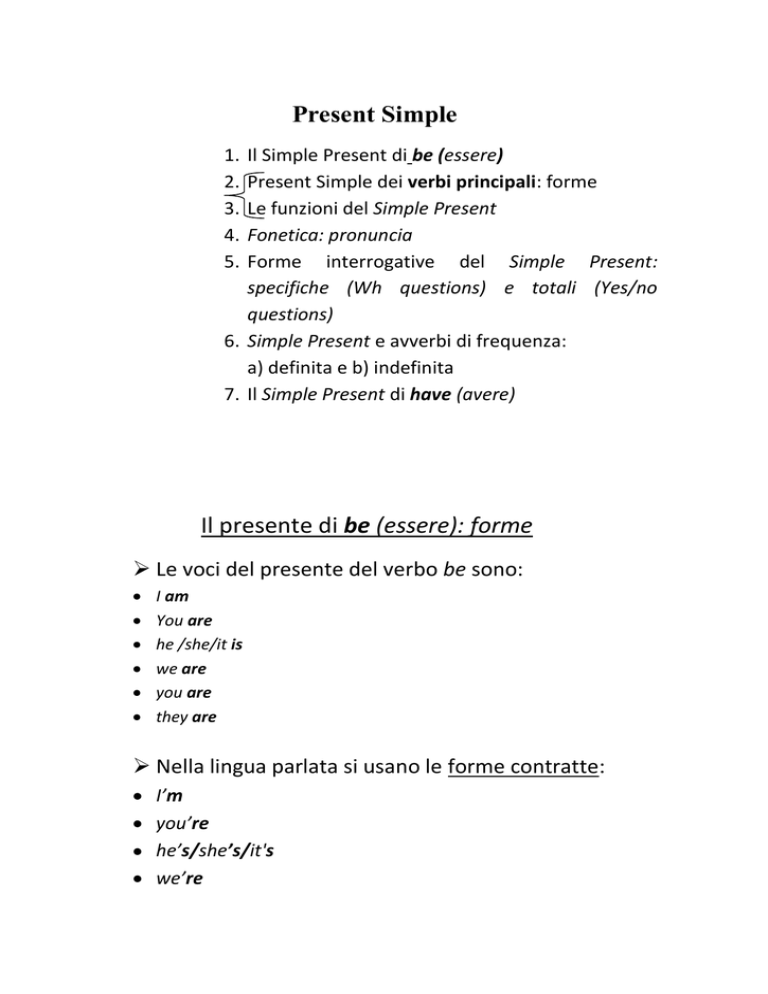
Present Simple
1.
2.
3.
4.
5.
Il Simple Present di be (essere)
Present Simple dei verbi principali: forme
Le funzioni del Simple Present
Fonetica: pronuncia
Forme interrogative del Simple Present:
specifiche (Wh questions) e totali (Yes/no
questions)
6. Simple Present e avverbi di frequenza:
a) definita e b) indefinita
7. Il Simple Present di have (avere)
Il presente di be (essere): forme
Le voci del presente del verbo be sono:
I am
You are
he /she/it is
we are
you are
they are
Nella lingua parlata si usano le forme contratte:
I’m
you’re
he’s/she’s/it's
we’re
you’re
they’re
La forma negativa si ottiene aggiungendo not:
I am not
you are not
he/she/it is not (n’t)
we are not
you are not
they are not
La forma interrogativa si ottiene invertendo la
posizione del soggetto e del verbo:
Am I? Are you/we/they? Is he /she/it/?
La forma interrogativa negativa:
Am I not? Aren’t you/we/they?
Isn’t he/she/it?
I’m from New York. Where are you from?
(Io sono di New York. Tu di dove sei?)
Is Rita married? No, she isn’t.
(È sposata Rita? No)
My parents aren’t at home today.
(I miei genitori non sono a casa oggi)
Bisogna tenere presente che certe espressioni con
be (essere) corrispondono a forme italiane con
‘avere’:
be afraid/cold/hot/hungry/thirsty/in a
hurry/right/wrong(averepaura/freddo/caldo/fame/sete/fretta/ragio
ne/torto)
be 15/29 (years old) (Avere 15/29 anni)
I’m hot but I’m not thirsty. (ho caldo, ma non ho sete)
I think you’re right. (Penso che tu abbia ragione)
My grandmother is 89. (Mia nonna ha 89 anni)
Il Present Simple dei verbi principali: forme
o Il Present Simple si forma con l’infinito senza il to
(particella indicativa dell’infinito):
I work
you work
he /she work -s
we work
you work
they work
o Alla terza persona singolare (he/she/it) si aggiunge -s.
o Con i verbi terminanti in o,s,ch,x,sh si aggiunge –es.
Alcuni verbi come be e have sono irregolari.
he goes
Bob watches
she misses
he relaxes
o I verbi in -y preceduta da consonante terminano in –
ies alla terza persona singolare:
I play/she plays
we try /Bill tries.
I study/he studies
La forma negativa si costruisce con do not e il verbo
all’infinito senza to. Alla terza persona singolare si usa does
not work.
o Nel parlato e nei testi informali si usano le forme
contratte don’t e doesn’t.
I don’t work
You don’t work
She/he doesn’t work
We don’t work
You don’t work
They don’t work
Il Present Simple: significato
Si usa il Present Simple per descrivere:
Azioni abituali (presente iterativo, abituale): esprime
un’azione che, benché colta nel suo svolgimento
attuale, è presentata come abituale ed è idealmente
riferita anche al passato o al futuro:
I usually get up at 7:30.
(Di solito mi alzo alle 7:30)
Fatti, accadimenti e vicende personali:
Liz plays basketball
(Liz gioca a pallacanestro)
We like orange juice
(A noi piace il succo d’arancia)
Presente acronico: realtà che sono sempre vere “fuori
dal tempo”, in quanto ad essa viene attribuito validità
perenne, applicabilità universale:
The sun rises in the east
(Il sole sorge a est)
Fonetica:
La s della terza persona può essere pronunciata in tre
diversi modi:
[iz]
[s]
[z]
A) La terza persona singolare dei verbi che all’infinito
terminano con i suoni [s], [z], [∫], [t∫], [
pronuncia [iz]:
Es: close+s
watch+es
miss+es
], e [ks], si
relax+es
B) Dopo [f], [k], [p],[t], il suono finale è [s]
Hit+s
Cook+s
C) Negli altri casi la s della terza persona si pronuncia /z/
she see+s
read+s
Il Present Simple: forme interrogative
Le forme interrogative si costruiscono con l’ausiliare do
seguito dal soggetto e dal verbo all’infinito senza to. Alla
terza persona si usa si usa does invece di do:
A) Interrogative Polari (yes /no)(TOTALI O
CONNESSIONALI):
DO +SOGG. + VER. PRINC.+ COMPL.
Queste domande pongono un’alternativa:
Present Simple: Do you live in Scotland?
(abiti/vivi in Scozia?) “Yes/No”
Do I work
Do you work?
Does he/she work?
Do we work?
Do you work?
Do they work?
Forma interrogativa negativa:
Don’t you work?
(tu non lavori?)
Doesn’t he work?
(Lui non lavora?)
B) Interrogative Specifiche (Wh-) (Parziali o
nucleari)
Wh- + DO + SOGG. + V. P. + COMPL.
Si usa do/does anche nelle domande specifiche introdotte
da When (quando), What (che cosa), Why (perché), Where
(dove), How (come), ecc.
Simple Present: When do you usually leave?(Quando parti di
solito?) I usually leave on Monday
IMPORTANTE!!
Quando l’elemento Wh- funge da soggetto la domanda NON
ha struttura interrogativa, cioè NON vuole do/does oppure
l’inversione:
Es: What do you want?
Es: Who lives here?
Where does she live?
Which of you speaks English?
(O)What (aux)do (S)cats (V)eat? “((S)Cats (V)eat)
(O)fish”
“Che cosa mangiano I gatti?” “(I gatti mangiano) pesce”
Qui, WHAT è COMPLEMENTO, si riferisce a fish
(S)Who (V)eats (O)fish? “(S)Cats ((V)eat (O)fish)
(Chi mangia pesce?) “I gatti (mangiano pesce)
Qui,WHO è SOGGETTO, si riferisce a Cats.
Grammar. Questions.
1) The Louvre appears in the novel The Da Vinci Code.
(Yes/no)_______________________________________?
(Which French museum)_________________________________?
2) India makes the most films every year.
(Yes/no)_______________________________________________?
(What country) _________________________________________?
3) Rio de Janeiro has the most famous carnival every year.
(yes/no)_______________________________________________?
(Which city)____________________________________________?
4) The Canadians uses the Internet more than the Americans.
(yes/no)________________________________________________?
(Who)_________________________________________________?
5) Canadians spend over forty hours a month online.
(yes/no)________________________________________________?
(How many hours)______________________________________?
6) The Carcross Desert in Canada is the smallest desert in the world.
(yes/no)________________________________________________?
(What)_________________________________________________?
7) On Saturday night I often go clubbing.
(Yes/ no)_______________________________________________?
(What)_________________________________________________?
8) They work outside London.
(Yes/no)_______________________________________________?
(Where)_______________________________________________?
9) I have breakfast at about 8 o’clock.
(yes/no)______________________________?
(What time)______________________________?
Il Present Simple e gli avverbi di frequenza
b) Indefinite frequency b) definite frequency
a) Indefinite frequency
These adverbs say how often something happen. Determinano in
modo imprecisato, non definito il tempo di svolgimento di un’azione:
Always (sempre), often (spesso), usually (solitamente), sometimes (qualche
volta), rarely (raramente), never (mai), ecc.
La posizione degli avverbi di frequenza: A) prima dei verbi
lessicali); dopo B) il verbo to be (am/are/is/was/were;
A) prima del verbo principale:
I usually get up at 7.00. (Di solito mi alzo alle 7)
Pat often goes to the cinema. (Pat va spesso al cinema)
It usually rains when I go on holiday.(Di solito piove quando vado in
vacanza)
We sometimes eat pizza for lunch. (A volte mangiamo la pizza a
pranzo)
My bus never arrives on time (Il mio autobus non arriva mai in
orario)
Nelle frasi negative si trovano dopo il verbo ausiliare e prima del
verbo principale:
I don’t often go to the cinema.
Alcune eccezioni: Usually (solitamente), normally (normalmente),
often (spesso), frequently (frequentemente), sometimes (qualche
volta), occasionally (occasionalmente) possono anche collocarsi in
posizione iniziale di frase:
Usually I get up early
B) Con il verbo ausiliare be gli avverbi di frequenza seguono
il verbo:
Jim is usually late (Di solito Jim è in ritardo)
B) Definite frequency
These adverbs say how often something happen. Indicano un
riferimento temporale definito, specificato, ben delineato, ecc.:
daily (quotidianamente), weekly (settimanalmente), every year (ogni
anno), every day (ogni giorno), every week (ogni settimana).
Position: end position; initial position.
She goes to the cinema every week;
Every week she goes to the cinema
Il Presente di have (got)
Le voci del presente sono:
Forma affermativa:
I /you/we/they/have got
he/she/it/has (got)
Forma negative:
I/you/we/they haven’t got
he/she/it hasn’t got
Forma interrogativa:
have I/you/we/they/(got)?
A) Usando have senza got (ad esempio nell’angloamericano), la forma negativa e interrogativa si
possono costruire do/does. Confronta:
Es: I’ve got a sister.
Ing.
I have a sister.
I haven’t got a sister.
Has Tom got a sister?
I don’t have a sister. Does Tom have a sister? Amer.
Have è usato inoltre anche come verbo principale con
diversi significati:
I always have lunch at home (Io pranzo sempre a casa)
Do you usually have a shower or a bath? (Di solito fai la doccia o il
bagno?)
Antonio Piga

